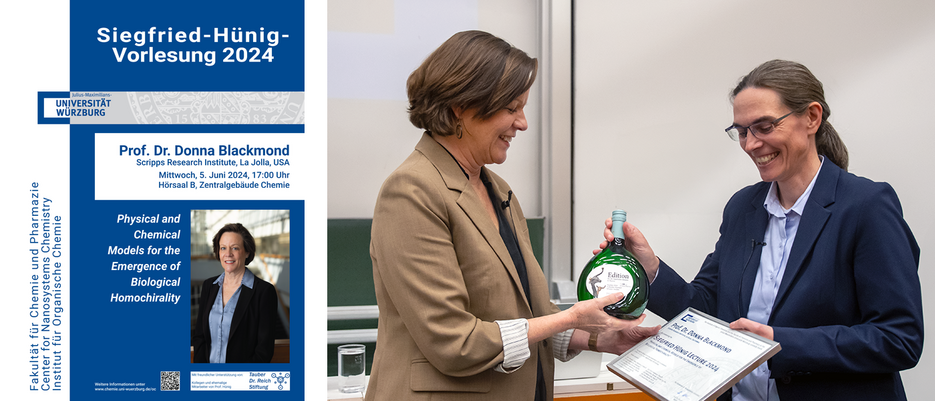Homochirality and the Origin of Life
06/07/2024Donna Blackmond, professor at the Scripps Research Institute in California, spoke about this topic on the occasion of the Siegfried Hünig Lecture 2024 at the Faculty of Chemistry and Pharmacy.
The origin of life on Earth is one of the great unsolved problems in science of our age. It has long been known that four billion years ago conditions existed for the emergence of the first organic molecules, from which the typical biomacromolecules could also develop, without which life on Earth would not be possible. But the origin of the homochirality of all natural biomolecules continues to be a mystery.
From Space to Earth?
In all living organisms, only L-amino acids and D-sugars are found as building blocks of the genetically encoded biopolymers, but not the respective enantiomers. There are various theories about this phenomenon. One of them is that at some point homochiral material reached Earth with meteorites. Donna Blackmond started her lecture entitled "Physical and Chemical Models for the Emergence of Biological Homochirality" with this theory. However, she is not an advocate of this theory herself and subsequently presented the impressive results of 20 years of research on this topic.
From Pasteur to Sodium Chlorate to the Homochirality of Biopolymers
The fact that Pasteur recognized the mirror-image symmetry of tartrate crystals by sorting them under the microscope with tweezers must have been known to everyone in the auditorium. The fact that the achiral salt sodium chlorate also crystallizes in two optically active forms and that one of the two forms is almost exclusively formed by stirring during crystallization should have surprised most people.
Using terms such as chiral amnesia and enrichment by eutectic partitioning, Donna Blackmond described the underlying physical and/or chemical processes. The proposed mechanisms of enantioenrichment of chiral molecules provide a plausible explanation for how one enantiomer might have come to dominate over the other from what presumably was a racemic prebiotic world. In addition, her findings have the potential to impact a wide range of applications in synthetic chemistry and the pharmaceutical industry.
Donna Blackmond
Donna Blackmond conducted research at the University of Pittsburg, in the pharmaceutical industry, at the MPI für Kohlenforschung in Mülheim, at the University of Hull and at Imperial College in London before moving to the Scripps Research Institute in La Jolla in California in 2010, where she has been conducting research ever since.
She is an elected member of numerous scientific societies and academies and has received many scientific honors, including the IUPAC Award for Distinguished Women in Chemistry or Chemical Engineering and the Humboldt Research Award of the Alexander von Humboldt Foundation.
Siegfried Hünig
Prof. Dr. Dr. h.c. mult. Siegfried Hünig, born in 1921, was a visionary chemist after whom not only the world-famous Hünig Base was named, but who also set important initial impulses in several fields of physical-organic chemistry and, as a passionate university lecturer and institute director, was also formative for the development of the chemical institutes in Würzburg in the second half of the 20th century. He died in 2021, a few days before his 100th birthday and before his inclusion in the "Heroes of Chemistry" section of the journal Angewandte Chemie.
In his honour, the Siegfried Hünig Lecture was established already during his lifetime in 2011. An internationally renowned chemist is invited to give this named lecture in Würzburg once a year.
Links
The Siegfried Hünig Lecture: Information and Chronology
Website of Prof. Dr. Donna Blackmond (Scripps Research Institute)



